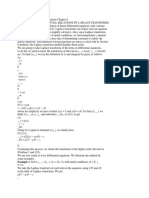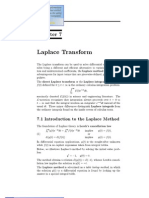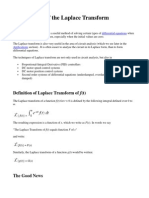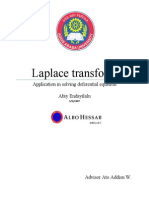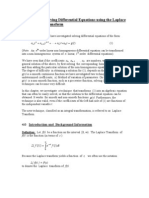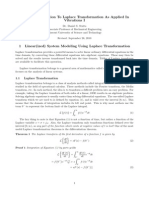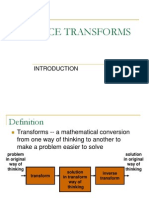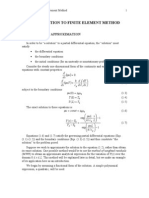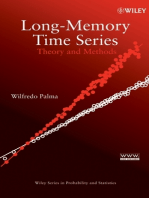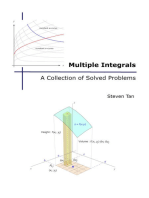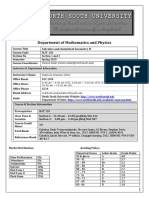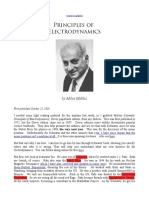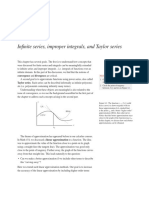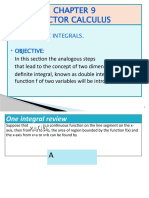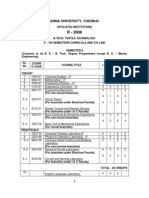Notes On Numerical Laplace Inversion
Notes On Numerical Laplace Inversion
Uploaded by
djfwalkerCopyright:
Available Formats
Notes On Numerical Laplace Inversion
Notes On Numerical Laplace Inversion
Uploaded by
djfwalkerOriginal Description:
Original Title
Copyright
Available Formats
Share this document
Did you find this document useful?
Is this content inappropriate?
Copyright:
Available Formats
Notes On Numerical Laplace Inversion
Notes On Numerical Laplace Inversion
Uploaded by
djfwalkerCopyright:
Available Formats
Notes on Numerical Laplace Inversion
Kathrin Spendier
April 12, 2010
Introduction
The main idea behind the Laplace transformation is that we can solve an equation (or system
of equations) containing differential and integral terms by transforming the equation in time (t)
domain into Laplace () domain. For example, we can use Laplace transforms to turn an initial
value problem into an algebraic problem which is easier to solve. After we solved the problem in
Laplace domain we find the inverse transform of the solution and hence solved the initial value
problem. The Laplace transform of f (t) is:
Z
f () =
et f (t) dt,
(1)
where is a complex variable known as the Laplace variable. The inverse integral is defined as the
Bromwich contour integral ( + i) as:
1
f (t) =
2i
+i
Z
et f ()d.
(2)
is chosen so the all singular points of f () lie to the left of the line Re() = in the complex
-plane.
In simple cases the inverse transform can be found via analytical methods or with the help of
tables. You can also compute the Laplace transform by evaluation of the complex integral of inverse transformation. Unfortunately, it is not always easy to find the inverts. One possible reason
is that the inverse is not a named function or can not be represented by a simple formula. Moreover, if the Laplace transform is computable or measurable on the real and positive axis only the
problem is ill-posed. Two time domain functions which differ at a single point in time for example
will have the same transform. This case is very complicated simply because of absence of the exact
inversion formula. In these cases a numerical method must be used. There are several numerical
algorithms in literature and each individual method has its own applications and is suitable for a
particular type of functions [1]. In this report I will briefly introduce the Fourier Series expansion
and the Gaver-Stehfest method.
1.1
What is the Challenge of Numerical Laplace Inversion?
The numerical inversion of f (t) depends on the sensitivity of the inversion procedure. This is
clear when we consider the need to multiply by a potentially increasing large exponent et in Eq.2.
Algorithmic and finite precision errors (i.e. increasing round off error for large numbers) can lead
to exponential divergence of numerical solutions.
Fourier Series Expansion
This method is based on the Bromwich contour inversion integral, which can be expressed as the
integral of a real valued function of a real variable by choosing a specific contour. One first converts
the inversion integral into the Fourier transform and then approximates the transform by a Fourier
series (use trapezoidal rule) with a specific discretization error.
As mentioned, the method [2] utilizes the standard Bromwich contour + i (choose a
specific contour) to rewrite the Laplace transform integral given in Eq.2 as:
et
f (t) =
2
Z
eit f ( + i)d,
(3)
which is in the form of a Fourier transform. We can even go further and rewrite eit in Eq.3 to
obtain:
Z
et
[cos (t) + i sin (t)] f ( + i)d.
(4)
f (t) =
2
Equation 4 can then be rewritten in real and imaginary parts
et
f (t) =
2
Z h n
o
n
o
i
Re f ( + i) cos (t) Im f ( + i) sin (t) d.
(5)
With the assumption that f (t) is non-negaive, f (t) = 0 for t > 0, and Re(f) is even and Im(f)
is odd we are only interested in the real part and we may write:
2et
f (t) =
n
o
Re f ( + i) cos (t)d.
(6)
Equation 6 can now be approximated by the trapezoidal rule
Zb
ba
f (x) dx
n
f (a) + f (b)
2
with a step size h =
n1
X
ba
+
f a+k
n
k=1
ba
:
n
o 2het X
n
o
het n
f (t)
Re f ( + i) +
Re f ( + ikh) cos (kht) ,
k=1
(7)
and can be further simplified if h =
2t
and =
A
2t
and written as a nearly alternating series:
A/2 X
A
A
+
2ki
eA/2
e
k
(1) Re f
f (t)
Re f
+
.
2t
2t
t k=1
2t
(8)
Equation 8 can now be computed numerically by summing over a finite number of k. Hence, A
and k are parameters which must be optimized for increasing accuracy. This method turns out to
be very accurate. The disadvantage of this method is that it is difficult to implement and requires
a large computation time [3] (i.e. sum over many terms).
Gaver-Stehfest Method
This method requires sampling of the Laplace space function f() only on the real line and is
explained in detail in Refs [5] and [6]. Similarly to the Fourier Method, we make the following
transformation in Eq.2. We define a new complex variable z = t and rewrite Eq.2 as:
Z
1
z z
f (t) =
f
e dz,
(9)
2it
t
C0
where C 0 is the same contour as in Eq.2 as a function of z. Next we approximate ez by a rational
function
n
X
k
z
e
,
k z
k=0
where k and k are complex numbers and called weights and nodes respectively. Using this
approximation and applying the Cauchy integral formula we obtain
1 X k
k f
.
f (t)
t k=0
t
n
(10)
Equation 10 approximates the inverse Laplace transform by a linear combination of transform
values. The nodes and weights are complex numbers but do not depend on f of the function argument t, but typically depend upon n. Since the weights are initially left unspecified it is typically
called a framework rather than algorithm. Hence, Eq. 10 is referred to as Unified Framework for
Numerical Laplace Inversion [4] since many different algorithms can be but into this framework,
even the Fourier method (or Euler) for which the nodes are complex values, Eq.8 [4].
The Gaver-Stehfest method considers the case in which f (t) is real-valued and the weights and
nodes are real which leads to very accurate result for functions of type et . The Stehfests algorithm is based on a probabilistic derivation [5] and approximates the time domain solution using
the following equation [1,4]:
2M
ln (2) X k ln (2)
f (t)
,
k f
t k=1
t
(11)
with the weights
min(k,M )
k = (1)
M +k
j=b(k+1)/2c
j M +1
M!
M
j
2j
j
j
kj
where bxc being the greatest integer or less than or equal to x. I implemented Eq. 11 and 12 in
Matlab using double precision, which restricts M to be less than 7. Hence, the Gaver-Stehfest
method only evaluates the function at real and positive values of the Laplace variable and sums
a total of 14 (2M ) terms. This method is easy to implement and very accurate for functions of
type et . For functions with oscillatory behavior in time domain, the Gaver-Stehfest algorithm
fails.
3.1
Some Numerical Inversion Examples implemented in Matlab
In Fig.1, I inverted f() = 1/ ( + 1) numerically and compared it to the known analytic solution
in time domain f (t) = et . As expected the Graver-Stehfest method approximates the solution
very well.
1
numerical
analytical
0.8
f(t)
0.6
0.4
0.2
0
0
10
Figure 1: Numerical Inversion (black dots) compared to analytic solution (red line) for f (t) = et .
In Fig.2, I inverted f() = 1/ (2 + 1) numerically and compared it to the known analytic
solution in time domain f (t) = sin(t). This is an example for which the Graver-Stehfest method
fails. Only for short time we obtain a good approximation.
numerical
analytical
f(t)
0.5
0.5
1
0
10
Figure 2: Numerical Inversion (black dots) compared to analytic solution (red line) for f (t) =
sin(t).
References
[1] Hassan Hassanzadeh, and Mehran Pooladi-Darvish (2007), Comparison of different numerical
Laplace inversion methods for engineering applications, Applied Mathematics and Computation,
189:1966-1981.
[2] Joseph Abate (1995), Numerical Inversion of Laplace Transforms of Probability Distributions,
ORSA Journal on Computing, 7:36-43.
[3] Kenny S. Crump (1976), Numerical Inversion of Laplace Transforms Using a Fourier Series
Approximation, Journal of the Association for Computing Machinery, 23:89-96.
[4] Joseph Abate and Ward Whitt (2006), Unified Framework for Numerically Inverting Laplace
Transforms, INFORMS Journal on Computing, 18:408-421.
[5] D. P. Gaver Jr. (1966), Observing Stochastic Processes and Approximate Transform Inversion,
Operations Research, 14:444-459.
You might also like
- 50 Challenging Calculus Problems (Fully Solved) - Chris McMullenDocument236 pages50 Challenging Calculus Problems (Fully Solved) - Chris McMullenLodavin100% (12)
- Laplace Transform - Aminul Haque, 2224EEE00222Document25 pagesLaplace Transform - Aminul Haque, 2224EEE00222Ãmîñûł Hãqûê AHNo ratings yet
- An Introduction Into The Feynman Path Integral PDFDocument94 pagesAn Introduction Into The Feynman Path Integral PDFLivardy WufiantoNo ratings yet
- Laplace and Fourier Transforms: P.C. Chau, UCSD C 2000Document2 pagesLaplace and Fourier Transforms: P.C. Chau, UCSD C 2000MachodogNo ratings yet
- Laplace Transform Numerical Inversion PDFDocument18 pagesLaplace Transform Numerical Inversion PDFTheNourEldenNo ratings yet
- 440 Ordinary Differential Equations Chapter 8Document11 pages440 Ordinary Differential Equations Chapter 8Anonymous ZuOYBjgPNo ratings yet
- Laplace TransformDocument35 pagesLaplace TransformBravo AagNo ratings yet
- LaplaceDocument13 pagesLaplaceMuhammad UmairNo ratings yet
- Phase Transitions in Field Theories at Finite Temperatures: 1 MotivationDocument5 pagesPhase Transitions in Field Theories at Finite Temperatures: 1 MotivationchichieinsteinNo ratings yet
- The Transform and Its Inverse: PrerequisitesDocument23 pagesThe Transform and Its Inverse: PrerequisitesasmitajashNo ratings yet
- Laplace Transform - Aminul Haque, 2224EEE00222Document25 pagesLaplace Transform - Aminul Haque, 2224EEE00222Ãmîñûł Hãqûê AHNo ratings yet
- LAPLACE FormulaeDocument25 pagesLAPLACE FormulaeMalluri Veera BrahmamNo ratings yet
- Laplace TransformDocument30 pagesLaplace TransformkreposNo ratings yet
- Not-So-Complex Logarithms in The Heston ModelDocument16 pagesNot-So-Complex Logarithms in The Heston ModelIlham FalaniNo ratings yet
- F AnalysDocument16 pagesF Analysjcpa1000No ratings yet
- Markov Semigroups: Paolo GuiottoDocument26 pagesMarkov Semigroups: Paolo GuiottoChristina JonesNo ratings yet
- Convolution TheoremDocument16 pagesConvolution TheoremMuhammad UmairNo ratings yet
- The Laplace TransformationDocument6 pagesThe Laplace TransformationMostafa FawzyNo ratings yet
- Logarithmic Fourier Transformation: G. V. Haines and Alan G. JonesDocument8 pagesLogarithmic Fourier Transformation: G. V. Haines and Alan G. Jonesdautroc13No ratings yet
- James G. O'BrienDocument10 pagesJames G. O'BrienIrwan RahmanNo ratings yet
- Abiy Laplace TransformDocument20 pagesAbiy Laplace TransformMiliyon TilahunNo ratings yet
- Laplace Transformations 2Document26 pagesLaplace Transformations 2Soumyadeep MajumdarNo ratings yet
- Heaviside Operational Calculus by J R CarsonDocument26 pagesHeaviside Operational Calculus by J R CarsonGeraldo Carvalho Brito Jr.No ratings yet
- A Brief Introduction To Laplace Transformation - As Applied in Vibrations IDocument9 pagesA Brief Introduction To Laplace Transformation - As Applied in Vibrations Ikravde1024No ratings yet
- InstructionsDocument9 pagesInstructionsapi-284738200No ratings yet
- Lecture5 (Amplifier Noise Etc)Document5 pagesLecture5 (Amplifier Noise Etc)Jaime BerryNo ratings yet
- Winitzki - Derivation of WKB ApproximationDocument2 pagesWinitzki - Derivation of WKB ApproximationwinitzkiNo ratings yet
- Application of Laplace TransformDocument35 pagesApplication of Laplace TransformSingappuli100% (1)
- Homework Set 3 SolutionsDocument15 pagesHomework Set 3 SolutionsEunchan KimNo ratings yet
- Final ReportDocument5 pagesFinal ReportMike BreskeNo ratings yet
- Unit 6 Laplace Transfrom Method: Structure NoDocument46 pagesUnit 6 Laplace Transfrom Method: Structure NoJAGANNATH PRASADNo ratings yet
- AdvMath (Unit 2)Document24 pagesAdvMath (Unit 2)Ivan Paul SyNo ratings yet
- Midterm Solutions 2013Document12 pagesMidterm Solutions 2013Nonitus OctingentiNo ratings yet
- Notes LT1Document21 pagesNotes LT1deathesNo ratings yet
- Laplace Transformation PDFDocument114 pagesLaplace Transformation PDFHector Ledesma III100% (1)
- FORTRAN 77 Lesson 7: 1 Numerical IntegrationDocument7 pagesFORTRAN 77 Lesson 7: 1 Numerical IntegrationManjita BudhirajaNo ratings yet
- Laplace Transform Numerical InversionDocument18 pagesLaplace Transform Numerical InversionIslam ZewainNo ratings yet
- Laplace TransformDocument35 pagesLaplace TransformAnujPatelNo ratings yet
- Draft Report: Srivatsan April 3, 2014Document4 pagesDraft Report: Srivatsan April 3, 2014chichieinsteinNo ratings yet
- An Introduction To The Split Step Fourier Method Using MATLABDocument15 pagesAn Introduction To The Split Step Fourier Method Using MATLABHafiz Faiz RasoolNo ratings yet
- Invlap, KDocument10 pagesInvlap, KMohamed AdelNo ratings yet
- Laplace Transforms1Document110 pagesLaplace Transforms1nileshsawNo ratings yet
- Lecture5 (Amplifier Noise Etc)Document5 pagesLecture5 (Amplifier Noise Etc)bitconcepts9781No ratings yet
- Convolution 18.031, Haynes Miller and Jeremy OrloffDocument10 pagesConvolution 18.031, Haynes Miller and Jeremy OrloffPrineezyNo ratings yet
- Fourier TransformDocument35 pagesFourier TransformThanatkrit KaewtemNo ratings yet
- Brannan de 3e PPT Ch5ADocument46 pagesBrannan de 3e PPT Ch5ADawna Lee AttigNo ratings yet
- La Place TransformDocument8 pagesLa Place Transformreliance2012No ratings yet
- On Volterra Integral EquationsDocument6 pagesOn Volterra Integral EquationsLuis Alberto Fuentes0% (1)
- Unit-III Laplace TransformDocument30 pagesUnit-III Laplace TransformRochakNo ratings yet
- Laplace TransformDocument2 pagesLaplace Transformrowjatul.jannat.austNo ratings yet
- Regularization of Feynman IntegralsDocument28 pagesRegularization of Feynman Integralscastillo61No ratings yet
- Introduction To Finite Element Method: The Nature of ApproximationDocument10 pagesIntroduction To Finite Element Method: The Nature of ApproximationIsrael AGNo ratings yet
- TransformationsDocument34 pagesTransformationsRigo Martinez MNo ratings yet
- Mathematical Techniques III (PHY 317) Answers For Exercise Class 8Document5 pagesMathematical Techniques III (PHY 317) Answers For Exercise Class 8Tri Phương NguyễnNo ratings yet
- Green's Function Estimates for Lattice Schrödinger Operators and ApplicationsFrom EverandGreen's Function Estimates for Lattice Schrödinger Operators and ApplicationsNo ratings yet
- Student Solutions Manual to Accompany Economic Dynamics in Discrete Time, second editionFrom EverandStudent Solutions Manual to Accompany Economic Dynamics in Discrete Time, second editionRating: 4.5 out of 5 stars4.5/5 (2)
- Convolution and Equidistribution: Sato-Tate Theorems for Finite-Field Mellin TransformsFrom EverandConvolution and Equidistribution: Sato-Tate Theorems for Finite-Field Mellin TransformsNo ratings yet
- The Math You Need For Data ScienceDocument29 pagesThe Math You Need For Data Scienceisra figueirido arnosoNo ratings yet
- Tekla Structure Analysis & Design Link With Analysis SoftwareDocument6 pagesTekla Structure Analysis & Design Link With Analysis SoftwareYoung JekalNo ratings yet
- Department of Mathematics and Physics: Calculus and Analytical Geometry IIDocument4 pagesDepartment of Mathematics and Physics: Calculus and Analytical Geometry IIYoutube BrowserNo ratings yet
- Syllabus DBATUDocument88 pagesSyllabus DBATUShivanand ArwatNo ratings yet
- AEIE Proposed 2nd Year Syllabus-15.12.11Document24 pagesAEIE Proposed 2nd Year Syllabus-15.12.11susamayNo ratings yet
- Hillier (2008) - Using DepthMap For Urban AnalysisDocument4 pagesHillier (2008) - Using DepthMap For Urban AnalysisAgatha Knox FigueiraNo ratings yet
- An Approximation of Phosphorescence Decay Kinetics of IdealDocument10 pagesAn Approximation of Phosphorescence Decay Kinetics of IdealMatija KorvinNo ratings yet
- B.tech MDU Syllabus (CSE)Document83 pagesB.tech MDU Syllabus (CSE)Prakshi JainNo ratings yet
- Rajesh Madan'S: Mathematics ClassesDocument8 pagesRajesh Madan'S: Mathematics ClassesPratham MalhotraNo ratings yet
- StewartCalcET8 15 05Document12 pagesStewartCalcET8 15 05OhoodKAlesayiNo ratings yet
- 001 Introduction Integral CalculusDocument36 pages001 Introduction Integral CalculusAj EstradaNo ratings yet
- Principles of Electrodynamics BY MILES MATHISDocument10 pagesPrinciples of Electrodynamics BY MILES MATHISlennysanchezNo ratings yet
- 8 Infinite Series, Improper Integrals, and Taylor Series: Mastered Material CheckDocument28 pages8 Infinite Series, Improper Integrals, and Taylor Series: Mastered Material CheckareejaNo ratings yet
- PG MathsDocument22 pagesPG MathsMarikannanNo ratings yet
- Vector Calculus: 9.10 Double Integrals. ObjectiveDocument36 pagesVector Calculus: 9.10 Double Integrals. ObjectiveJacynthe GaudetteNo ratings yet
- 1.1. School of Aerospace and Mechanical Engineering: Courses OfferedDocument20 pages1.1. School of Aerospace and Mechanical Engineering: Courses OfferedAerospaceBishal Mozart GhimireyNo ratings yet
- Textile TechnologyDocument80 pagesTextile TechnologyJagan KumarNo ratings yet
- ImproperDocument8 pagesImproperWarda JoryNo ratings yet
- Ader Schemes For Three-Dimensional Nonlinear Hyperbolic Systems V.A. Titarev and E.F. ToroDocument25 pagesAder Schemes For Three-Dimensional Nonlinear Hyperbolic Systems V.A. Titarev and E.F. TorovipulugaleNo ratings yet
- MHT Cet Maths Triumph STD 11th and 12th MCQ Hints1561554568Document699 pagesMHT Cet Maths Triumph STD 11th and 12th MCQ Hints1561554568Atharva ShitoleNo ratings yet
- Computer Science Bs Syl Lab UsDocument34 pagesComputer Science Bs Syl Lab UsWaqas KhanllaNo ratings yet
- ContinueDocument2 pagesContinueMUDUNURI SRIRAM ee16b027No ratings yet
- B.tech. Curriculum 2018-19 With CO-PO MappingDocument180 pagesB.tech. Curriculum 2018-19 With CO-PO MappingRevanth PolicherlaNo ratings yet
- Elementary Complex AnalysisDocument16 pagesElementary Complex Analysisosama hasanNo ratings yet
- KSSC 3 2007 7 4 297 (C)Document13 pagesKSSC 3 2007 7 4 297 (C)ismael.lorandi623No ratings yet
- Productflyer - 978 0 387 95063 1 PDFDocument1 pageProductflyer - 978 0 387 95063 1 PDFRdcNo ratings yet
- L-1 - Indefinite Integration PDFDocument36 pagesL-1 - Indefinite Integration PDFSubham SharmaNo ratings yet
- Module 8 - Basic Calculus - Week 32Document16 pagesModule 8 - Basic Calculus - Week 32Antonette CastilloNo ratings yet





